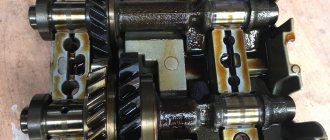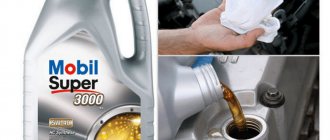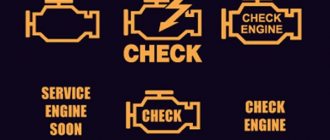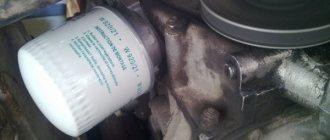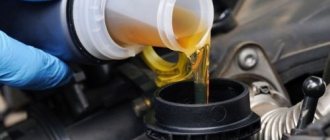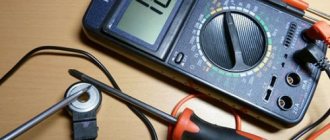One common problem with a turbocharger is the release of engine oil into the intake manifold (or intercooler, if equipped) or into the exhaust system. But is it always possible to clearly judge that the turbine is malfunctioning with such symptoms? No, not always. There are a number of reasons why even a fully functional turbocharger throws oil into a hot or cold scroll, or both at once.
Let's look at the design of one of the most common turbochargers used in passenger cars, produced by Garrett GT15. The internal cavity of the turbocharger bearing housing is isolated from the engine intake system by an O-ring and from the exhaust system by an O-ring. But while these rings help prevent oil leaks (especially at engine idle when the turbocharger rotor speed is low), they are not actually the main oil seals. They must be considered as elements that impede the leakage of air and gases between the turbine, compressor and bearing housing. In normal operation of a turbocharger, the pressure in the turbine and compressor is greater than the pressure in the bearing housing.
Some of the gases from the turbine and part of the air compressed in the compressor enter the bearing housing and, together with the engine oil, pass through the oil drain line into the engine oil sump.
The main oil seals of a turbocharger are dynamic type seals that use centrifugal forces to prevent oil leakage from the bearing housing. There are two grooves on the shaft on the turbine wheel side. The groove located closer to the turbine wheel is intended for installing an O-ring into it. The second groove and the difference in diameters act as a dynamic oil seal. Waste oil, under the influence of centrifugal forces, is sprayed inside the bearing housing and then flows through the oil drain hole of the turbocharger.
The dynamic oil seal on the compressor side works in a similar way. Its role is played by the difference in diameters of the outer thrust bushing.
The use of other oil seals in turbochargers (for example, oil seals, cuffs, etc.) is not possible due to the enormous speeds of rotation of the shafts, at which the contact seal systems will firstly create too much resistance to shaft rotation, and secondly they will come out of service too quickly building. True, there are so-called carbon oil seals - an analogue of stuffing box seals (such seals are used in automobile water pumps), but carbon seals are used only on low-speed turbines (up to 80 thousand rpm), and not on all of them.
So, the main condition for the normal operation of a turbocharger (in terms of the absence of oil leaks) is the normal operation of its dynamic seals. Dynamic seals, in turn, can operate normally only in air space, that is, only when the internal cavity of the bearing housing is free of engine oil. If for some reason the bearing housing is filled (“propped up”) with oil or the pressure balance inside and outside the bearing housing is disturbed, the dynamic seals practically stop working, and oil leaks through the sealing rings into the compressor housing and into the turbine housing.
Let's look at the reasons why this situation arises.
The engine crankcase ventilation system does not work (or does not work well) for some reason.
The crankcase ventilation system of any internal combustion engine is designed to eliminate excess pressure in the crankcase resulting from the breakthrough of gases from the combustion chamber into the crankcase during engine operation. The crankcase ventilation pipe of any internal combustion engine is connected to the low pressure zone (i.e., vacuum). In non-turbocharged engines this is usually the intake manifold; in turbocharged engines it is the intake manifold of the turbocharger. The turbocharger oil return line is connected to the engine oil system, usually below the normal oil level in the crankcase. Thus, if excess pressure of crankcase gases occurs in the crankcase, the oil cannot drain normally through the drain line of the turbocharger; it is “backed up” in the bearing housing with all the ensuing consequences. The reason for this may be severe coking of the oil separator of the crankcase ventilation system, coking of the crankcase ventilation system pipe, fracture or clamping of this pipe, etc.
The normal drainage of used oil through the turbocharger drain line is difficult for various reasons (coking, ingress of foreign objects, remnants of an old gasket, sealant). Identifying and eliminating this cause is not difficult.
Air intake to the turbocharger is difficult. Simply put, the air filter is “clogged” or the air intake pipe is partially blocked (for example, it is severely bent, thereby reducing its flow area).
When a turbocharger operates, dynamic forces create a certain vacuum behind the turbine wheel rotating at high speed. If excessive resistance to air intake occurs, this vacuum increases many times, the oil is simply “sucked out” from the middle housing of the turbocharger.
It is difficult to release exhaust gases through the exhaust system.
Excessive resistance in the exhaust system (a clogged or coked catalyst, a faulty or jammed muffler bank, etc.) causes an increase in pressure in the “hot” turbocharger scroll, which will cause exhaust gases to break through into the middle housing of the turbocharger and increase the pressure inside it, which, in will in turn cause oil to be released from the compressor side.
If one or more of the above reasons is present, even a fully functional turbocharger will throw out oil and blue smoke will pour out of the exhaust pipe.
As a result, I would like to note that the appearance of oil in the intake manifold or intercooler may not have anything to do with the turbine at all. First of all, when such symptoms appear, you should check the entire engine crankcase ventilation system, what condition it is in and what is being done in it. If the ventilation system or, ultimately, the engine itself malfunctions, oil will flow through the crankcase ventilation pipe into the air supply pipe of the turbocharger and then into the intercooler and intake manifold.
Information taken from a post on the Audi Club forum from a participant with the nickname “athlete 44”.
Purpose of the intercooler
A special air cooler (radiator) that is necessary for efficient operation of a diesel engine is called an intercooler. Equipping the engine with a turbocharging system leads to an increase in the air temperature in the fuel mixture to 200 degrees. As a result, the mixture expands and does not burn completely. To prevent diesel engine power loss under these conditions, an intercooler is installed after the turbine, which significantly reduces the temperature of the air leaving it.
Thus, the intercooler is essentially a set of tubes with a high level of thermal conductivity, thanks to which excess heat is removed and cooled oxygen enters the diesel engine.
Additional advantages of using a cooler are:
- reduction of environmentally hazardous emissions into the environment,
- increasing the engine's response speed to changes in fuel supply,
- limiting fuel consumption.
The following diagram will help you better understand how the device works:
There are two types of intercoolers:
The structure of the air intercooler includes a kind of honeycomb through which air moves under pressure. These coolers are the most popular. Their main advantages are practicality and affordable price. However, they are large in size and require a lot of free space to place them under the hood. It is also important that the cooling surface is clean and free of defects, otherwise the part will not function properly.
Liquid intercoolers are more convenient. The air in them is cooled by passing through a container of water. Such designs are compact, but require additional installation of a water pump, as well as an electronic control unit.
None of these types of intercoolers are immune to the problem of oil, which over time can develop into a malfunction of the entire turbocharged system.
Simple tasks to solve
- Oil line bend. This part is located between the turbine and the diesel engine crankcase; it is a drain pipe and must be level. The oil line is quite rigid and durable in its properties, but prolonged use can lead to its deformation. In this case, the pressure in the turbine increases, and oil appears in the intercooler through the sealing rings. This problem can be solved by aligning the oil line or replacing the seals. The entire part may also need to be replaced.
- Cracks or holes in the duct leading to the turbine. To ensure that oil no longer appears in the intercooler, damage to the air duct must be removed.
- A clogged oil filter prevents normal air movement. The consequence of this is the destruction of the seal rings and the appearance of oil in the intercooler. To fix the problem, you need to clean the filter, or better yet, replace it with a new one.
Complex tasks
- Clogged oil drain line. For example, to secure an oil line while repairing a diesel engine, you used conventional sealants. This may cause heat to cause them to enter the tube and cause it to clog. Careful cleaning of the oil line will help correct the situation.
- Crankcase ventilation problem. It can occur as a result of deformation of the sealing rings of the pistons and cylinders. In this case, the exhaust ends up inside the crankcase and throws oil into the intercooler through the drain pipe. This situation can be solved by serious repair of the diesel engine with the installation of new rings, pistons and seals.
Identifying the primary source of the problem of oil appearing in the intercooler and eliminating the malfunction is only part of the solution to the problem. You will definitely need to do a deep cleaning of the intercooler itself. It is necessary that the oil does not mix with the air that moves through the radiator and does not harm the quality of the fuel. Otherwise, the device will not be able to adequately cope with the functions assigned to it, and the advantages of its installation will be lost.
To clean the part, you can contact a service center, but this is a rather expensive procedure.
The algorithm for self-cleaning the intercooler is as follows:
- Remove the part.
- Clean the inside of any dirt.
- Remove oil.
- Dry.
- Return to original position.
The entire cycle may take you two to three hours.
The air-type device is simply dismantled: you need to remove the bolts with which it is secured and loosen the clamps. After this you can remove the intercooler. Removing liquid parts is more labor intensive and requires additional tools.
It is better to choose a cleaning agent for the device according to the vehicle’s operating instructions. Preparations such as gasoline, kerosene and white spirit for cleaning the intercooler should be used with caution and only after consulting with professionals. The fact is, these products can ruin the part, so using them for washing, you act at your own peril and risk. However, there is a lot of information on specialized forums confirming the use of these drugs with positive results and without harm to the cooler.
An intercooler with heavy contamination should be cleaned in four stages:
- First, we remove growths and stones mechanically and straighten the deformed areas.
- We use automotive chemicals to remove contaminants. We use, for example, the universal product Profoam 2000. It copes well with grease and adhered dirt. It is enough to spray it on the area requiring treatment and wash it off after 30 seconds. Profoam 2000 should be handled with gloves.
- We rinse the cooler of oil with products for cleaning the carburetor, engine or radiator in accordance with the instructions for the selected product.
- We wash away any remaining chemical cleaners with water.
It may take five to six washes to completely clean the part.
If it is discovered that there is a large amount of oil on the cooler honeycombs that cannot be washed off using universal automotive chemicals, then it may be necessary to add another intermediate cleaning step. It is necessary to fill the honeycomb parts with kerosene, gasoline or white spirit and leave it like that for a while until the oil gets wet. To do this, close the lower holes of the device and fill it with cleaning liquid through the top until its level completely covers the honeycomb.
The signal for the completion of the flushing cycle is the clean water leaving the cooler. Also, in a clean intercooler, light should pass through the plates well (no less than 80%).
At the last stage, you can blow the part with warm air under low pressure. Make sure that high temperatures and increased pressure do not damage the device.
The intercooler of a diesel engine requires regular preventative cleaning, even if there is no oil in it. During use, dust and various deposits accumulate in it, which disrupt heat transfer and reduce the efficiency of air cooling, which entails a loss of engine power.
Reasons for oil consumption in the turbine
Before moving on to considering the immediate reasons why oil may leak, it is necessary to determine its permissible volume. The fact is that any turbine, even a fully functional one, will eat up oil. And this consumption will be greater, the higher the speed of both the engine itself and the turbine. Without going into the details of this process, it should be noted that the approximate normal oil consumption of a turbocharged engine is about 1.5...2.5 liters per 10 thousand kilometers. But if the value of a similar consumption exceeds 3 liters, then this is already a reason to think about troubleshooting.
High oil consumption
We recommend: 10 most popular small cars in Russia and their problems
If the engine is consuming oil, this at least indicates a faulty CPG, worn oil caps or clogged crankcase ventilation. High oil consumption - signs, causes and what to do
Let's start with the simplest reasons why a situation may arise when oil is driven out of the turbine. As a rule, the situation is due to the fact that the locking rings, which, in fact, prevent oil from flowing out of the turbine, wear out and begin to leak. This happens due to the fact that the pressure in the unit drops, and in turn, oil drips from the turbine to where the pressure is lower, that is, out. So let's move on to the reasons.
Clogged air filter. This is the simplest situation, which, however, can cause this problem. You need to check the filter and, if necessary, replace it (in rare cases, you can clean it, but it’s still better not to tempt fate and install a new one, especially if you use the car off-road). In winter, instead of or along with clogging, in some cases it may freeze (for example, in conditions of very high humidity). In any case, you definitely need to check the condition of the filter.
Air filter box and/or intake pipe. The situation is similar here. Even if the air filter is in order, you need to check the condition of the indicated components. If they are clogged, you need to correct the situation and clean them. The resistance of the incoming air should be no higher than 20 mm of water column when the engine is idling (approximately 2 technical atmospheres, or about 200 kPa). Otherwise, you need to inspect and clean the system or its individual elements.
The air filter cover is not sealed properly. If such a situation occurs, then dust, sand and small debris will inevitably enter the air system. All these particles will work as an abrasive in the turbine, gradually “killing” it until it fails completely. Therefore, under no circumstances should depressurization of the air system of an engine with a turbine be allowed.
Poor quality or unsuitable oil. Any internal combustion engine is very sensitive to the quality of engine oil, and turbocharged engines are even more so, since their rotation speeds and temperatures are much higher. Accordingly, firstly, you must use the oil recommended by the manufacturer of your car. And secondly, you need to choose the lubricant that is of the highest quality, from a more well-known brand, synthetic or semi-synthetic, and not pour any surrogate into the power unit.
Heat resistance of oil. Turbine oil is usually more heat resistant than conventional oil, so an appropriate lubricant must be used. This oil does not burn, does not stick to the walls of the turbine elements, does not clog the oil channels and normally lubricates the bearings. Otherwise, the turbine will operate under extreme conditions and there is a risk of its rapid failure.
Oil change interval. In every engine, the oil must be changed according to regulations! This is especially true for turbocharged engines. It is better to carry out the corresponding replacement approximately 10% earlier than specified by the vehicle manufacturer according to the regulations. This will certainly increase the life of both the engine and the turbine.
After how many km should you change the engine oil?
We recommend: Purpose and types of axle shafts
The engine oil change interval should be considered based on operating conditions, vehicle mileage, quality of consumables and 7 other factors. Frequency 8-12 thousand km. general indicator
Condition of oil supply pipes. If you do not change the oil for a long time or use low-quality lubricating fluid (or the oil filter is simply clogged), then there is a risk that over time the oil pipes will become clogged and the turbine will operate in critical mode, which significantly reduces its service life.
Oil entering the intercooler (intake manifold) from the turbine. This situation occurs infrequently, but its cause may be the already mentioned clogged air filter, its cover or pipes. Another reason in this case may be clogged oil channels. As a result of this, a pressure difference occurs, due to which, in fact, the oil “spits out” into the intercooler.
Oil getting into the muffler. This is similar to the previous point. A pressure difference occurs in the system, which is caused either by a clogged air system (air filter, pipe, cap) or oil channels. Accordingly, first of all it is necessary to check the condition of the described systems. If this does not help, perhaps the turbine itself already has significant wear and needs to be inspected.
In some cases, this problem may be a consequence of the use of sealants during the installation of the supply and drain oil pipelines. Their residues could dissolve in the oil and cause the oil passages to become coked, including partial failure of the compressor bearings. In this case, it is necessary to clean the relevant channels and individual parts of the turbine.
Often, the result of oil getting into the muffler and the exhaust system in general will be blue smoke from the car's exhaust pipe.
Now we move on to more complex reasons, and therefore expensive repairs. They occur if the turbine is very worn out due to its improper operation or simply because of its “old age”. Wear could be caused by excessive load on the engine, the use of unsuitable or low-quality oil, its replacement not according to regulations, mechanical damage, and so on.
Failure of the impeller. This situation is possible if there was significant play on its shaft. This is possible either from old age or from exposure to abrasive materials on the shaft. In any case, the impeller cannot be repaired; it only needs to be replaced. In this case, related repairs are usually carried out. It hardly makes sense to carry them out on your own; it is better to seek help from a car service center.
Bearing wear. In this case, significant oil consumption is observed. And it can fall into the cavity, in close proximity to them. And since the bearings cannot be repaired, they need to be replaced. It is also better to seek help from a car service center. In some cases, the problem is not so much the direct replacement of bearings, but rather their selection (for example, for rare cars you need to order spare parts from abroad and wait a considerable time for them to be delivered).
Impeller shaft jamming. At the same time, it does not rotate at all, that is, the turbine does not work. This is one of the most difficult situations. Usually it jams due to misalignment. In turn, misalignment can occur due to mechanical damage, significant wear or failure of bearings. This requires comprehensive diagnostics and repairs, so you need to seek help from a car service center.
Car turbine malfunctions. How to troubleshoot?
Useful recommendations for troubleshooting a car engine turbine. 3 common causes of turbine malfunction and the main signs of turbocharger failure. And also how to eliminate them
On the importance of timely diagnosis
Please note that you should start eliminating the problem of oil appearing in the intercooler of a diesel engine immediately after you discover it. If the situation is delayed, the accumulated oil will be difficult to remove using universal means, and you will have to use expensive chemicals. Also, disturbances in the operation of a diesel engine, which are a consequence of the appearance of oil in the cooler, will worsen over time, and you will have to make considerable efforts to return the engine system to normal functioning.
If you were unable to find and fix the problem on your own, contact a car service specialist. To diagnose some breakdowns, you cannot do without professional equipment and the knowledge of a technician.
This video demonstrates the consistent cleaning of the intercooler from oil in a BMW X5:
Where can I apply for a refund on insurance?
Failed air vent If, when diagnosing the system, oil appears in the intercooler as a result of exceeding the oil level in the crankcase, this means that the crankcase ventilation is impaired, which means that the problem and its solution will be more serious and energy-consuming. If oil rushes into the intercooler for this reason, then most likely the seal is broken or the sealing rings of the cylinders and pistons are deformed. As a result, waste exhaust enters the crankcase and squeezes oil out into the intercooler. In this case, the only solution can be a major overhaul of the engine with replacement of rings, pistons, drain pipe, system seals, etc. 3 Cleaning a diesel engine part with your own hands Even if at the first stage you determined the cause of oil getting into the cooling mechanism and partially eliminated it, this does not guarantee normal operation of the system without cleaning the intercooler.
Diesel intercooler oil
As a result, the mixture itself expands greatly, becomes inhomogeneous and does not burn completely. To improve the characteristics of the drive unit, the mixture needs to be cooled - therefore, after the turbine it is worth installing a radiator, which is the intercooler. It allows you to achieve many positive changes, among which are:
- Increased engine power,
- Reducing the content of toxic substances in the exhaust,
- Reduced fuel consumption,
- Increasing the “elasticity” of the engine, that is, the speed of response to changes in fuel supply.
Video about how an intercooler works: Initially, intercoolers were intended exclusively for installation on diesel engines, which are very sensitive to elevated mixture temperatures - after all, an additional radiator reduces the temperature of the air leaving the turbine to 50–75 degrees.
Intercooler
During operation of the compressor, a lot of heat is generated. This leads to certain consequences. Thus, operating efficiency decreases, since it is more difficult for the turbine to compress hot air. And due to increased loads, parts and components of the structure wear out intensively. All this was the main reason for the failure of the turbocharger. To solve this problem, an intercooler was created. It is needed to lower the air temperature to the optimal value. In the automotive industry, air and liquid radiators are used.
Dirty business: why did oil appear in the intercooler and what to do with it?
If this is not done, the oil will gradually mix with the air that passes through the cooler and contaminate the fuel mixture, which will lead to deterioration in power, increased consumption and other unpleasant consequences. The most “severe” of them can be engine overheating as a result of ignition of a large amount of oil, this is especially true in the summer for diesel engines. Oil getting into the cooling mechanism The intercooler is cleaned using special auto chemicals after the part is completely removed from the car’s engine system. Most cars have an air-to-air intercooler. Removing it is usually not difficult. It is enough to read the vehicle's operating instructions, unscrew a few bolts, remove the clamps and remove the device from the system.
The main reasons for oil getting into the intercooler
Here are the main reasons why oil is driven into the intercooler:
- malfunction of the crankcase ventilation system,
- oil filter is clogged,
- dirty air filter,
- engine overheating,
- the turbine drives oil due to a damaged oil seal,
- bending of the turbine oil return line.
Malfunctions of the crankcase ventilation system
During sudden acceleration, driving on rough roads, and when working under heavy load, the pressure created by the burning air-fuel mixture is much higher than usual. Because of this, the amount of gases that break through the piston rings into the crankcase increases. If the crankcase ventilation system is working properly, then these gases pass through the intercooler, then enter the cylinders, where they burn along with the fuel. Over time, this system begins to work worse and worse. The oil catcher ceases to cope with its function, and the PCV valve spring loses its elasticity.
If the ventilation system does not work efficiently, the pressure in the crankcase increases, which is why oil droplets are driven into the intercooler radiator along with the gases. After cooling, they accumulate at the bottom of the intercooler. If the oil flows for this reason, then soon the excess pressure will lead to the seals being pressed and a leak will appear.
Clogged crankcase ventilation pipe
In addition, the lubrication characteristics will begin to deteriorate, the turbine will experience oil starvation, and scuffing will appear on the shaft. Another problem that can result from poor performance of this system is a drop in engine power and an increase in fuel consumption. Droplets of oil that the air flow throws into the cylinders will change the combustion mode of the fuel.
Oil filter clogged
If the oil filter is clogged, lubricant circulation is impaired and pressure increases at the same time. Because of this, the oil seals of the power unit are pressed, a leak occurs, and the turbine drives oil droplets into the intercooler. Installing a clean filter reduces oil leakage, but cannot eliminate it completely. Therefore, you will have to change all the seals.
Dirty air filter
When the intake valves are open and the piston goes down, a strong vacuum occurs in the pipe to which the output of the crankcase ventilation system is connected. If the air filter is clogged, then due to the pressure difference in the pipe and the system, gases come out much stronger and carry droplets of oil with them. In this case, the oil trap fails, causing lubricant to enter the intercooler. In addition, the lack of air greatly affects the composition of the air-fuel mixture. The mixture turns out to be over-enriched, and droplets of oil that enter the cylinders further change the ratio between air and fuel.
Motor overheating
In most cases, the motor boils when running for a long time at maximum power. If this happens, then increased oil evaporation caused by strong heating is added to the large volume of crankcase gases that break out of the cylinders. When the coolant boils, a vapor lock forms in the cylinder head (cylinder head). The temperature of the cylinder head increases greatly, which leads to increased evaporation of the lubricant. In addition, overheated oil becomes more liquid, causing worn oil seals to leak. Because of this, the turbine drives air with oil droplets, which changes the operating mode of the engine, reduces its service life, and also worsens performance characteristics.
Turbine leaks due to damaged oil seal
The turbine operates for 100–150 thousand kilometers using high-quality oil and normal pressure in the lubrication system. A deterioration in the quality of the lubricant or an increase in pressure leads to a leakage of the oil seal, which causes the turbine to throw droplets of oil into the intercooler radiator. For some time, the radiator can act as an oil catcher, preventing droplets from entering the cylinders.
As soon as the oil level reaches the lower cells, carburetion occurs, due to which the air flow begins to drag droplets of lubricant along with it, changing the composition of the air-fuel mixture.
Turbine return oil line bend
For normal operation of the turbine, oil must be drained without delay. If the oil line is severely bent for some reason, oil drainage will be difficult. The result of such a malfunction: a turbine that has leaked through the seals not only supplies compressed, purified air, but also throws droplets of lubricant into it.
Oil in the intercooler of a diesel engine causes
A dirty filter and dirty air line cause a vacuum that causes insufficient air to enter the cylinder. This leads to an over-enrichment of the air-fuel mixture and prevents the engine from operating in optimal mode.
The result of such a malfunction: a turbine that has leaked through the seals not only supplies compressed, purified air, but also throws droplets of lubricant into it.
To improve the characteristics of the drive unit, the mixture needs to be cooled - therefore, after the turbine it is worth installing a radiator, which is the intercooler.
Thanks to this, they not only avoid carburetion, but also determine the approximate condition of the engine and turbine. When the car's engine is fully operational, if oil appears in the intercooler, it is in insignificant quantities.
Next, we proceed to analyze the color of the exhaust gases. A drop in power and the black color of the diesel exhaust indicate an over-enrichment of the mixture. This may indicate an insufficient amount of air supplied to the cylinders due to malfunctions in the intake. The thrust of a diesel engine may also be lost as a result of exhaust leaks.
In addition, a thinner crankcase ventilation hose is embedded in the intake air line, connected to the crankcase through a positive ventilation valve (PCV valve). Thus, oil can come along with air from the air filter, from the turbine lubrication system, or from the crankcase.
The reason why oil is in the intercooler of a diesel engine has been clarified. A quick repair will get your car back on the road. The intercooler could work forever, if not for one “but”. After some time, many owners of turbocharged cars notice oil leaks at the joints of the hoses and radiator pipes. Oil drips indicate that oil has entered the cooling device. Where and how does it get there?
The intercooler of a diesel engine with a mileage of over 100 thousand kilometers almost always contains a small amount of oil (20-50 grams). Due to oil ingress, the air-fuel mixture does not have time to burn during the compression stroke, which is why it burns out in the cylinder head and exhaust manifold. The consequences of this are burnout of the valves and exhaust manifold.
Over the years, a car owner may encounter an unpleasant situation - oil appears in the intercooler pipe of a diesel engine. The reasons for this phenomenon may be different. From a simply clogged filter to problems with the turbine itself. Today we will look at why oil appears in the intercooler of a diesel engine and how to fix this problem.
If the oil filter is clogged, lubricant circulation is impaired and pressure increases at the same time. Because of this, the oil seals of the power unit are pressed, a leak occurs, and the turbine drives oil droplets into the intercooler. Installing a clean filter reduces oil leakage, but cannot eliminate it completely. Therefore, you will have to change all the seals.
Is it dangerous for oil to get into the intercooler?
The intercooler of a diesel engine with a mileage of over 100 thousand kilometers almost always contains a small amount of oil (20–50 grams). This is caused by the higher pressure generated during combustion of the air-fuel mixture. As long as the oil is below the level of the cooling cells, it does not affect the operation of the engine. When the intercooler radiator is filled with oil to the level of the lower cells, carburetion occurs.
Due to oil ingress, the air-fuel mixture does not have time to burn during the compression stroke, which is why it burns out in the cylinder head and exhaust manifold. The consequences of this are burnout of the valves and exhaust manifold.
The temperature of an overheated exhaust manifold reaches 700 degrees, which negatively affects the engine. After all, the temperature of the cylinder block begins to increase, the cooling system cannot cope with heat removal, which leads to overheating of the engine and a decrease in its service life.
Oil in the intercooler - what to do
Having found oil outside or inside the intercooler, it is necessary to determine why it got there. To do this, do the following:
- check the operation of the crankcase ventilation system,
- change oil and air filters,
- check the condition of the oil lines,
- check the turbine seals.
If you do not know how to carry out such diagnostics, visit a proven and reliable car service center. If the test results show that the engine is fully functional, reconsider your driving style. Rapid movement on a steep climb or mountainous terrain, long driving at engine speeds of more than 2 thousand per minute leads to an increase in coolant temperature.
Only after this is it necessary to start flushing the intercooler. You can flush the intercooler like this:
- remove the intercooler from the engine (read the repair and maintenance instructions for your car, it says how to do this),
- clean the outer surface of dirt with a broom and a stream of water,
- pour a mixture of gasoline, kerosene and acetone inside (ratio 1:1:1) and leave overnight,
- in the morning, drain the resulting slurry,
- mix hot water and dishwashing detergent (ratio 1:100), then pour this solution into the intercooler,
- To make the rinsing more effective, shake it vigorously for 2-3 minutes,
- drain the dirty water and repeat the same washing two more times,
- drain the flushing solution and rinse the intercooler with clean hot water.
Consequences of a collapsed turbine
Sometimes flushing is done with diesel fuel, acetone, carburetor cleaner or other light petroleum products. Some craftsmen, in order to simplify the maintenance of the intercooler, drill the lower part of the device body and weld a nut to it, into which a bolt with a copper washer is screwed. Every 3 months they remove the bolt and drain the oil. Thanks to this, they not only avoid carburetion, but also determine the approximate condition of the engine and turbine. When the car's engine is fully operational, if oil appears in the intercooler, it is in insignificant quantities.
Now you know why oil appears in the intercooler and what to do if this happens. This will allow you to detect a motor malfunction in time, quickly eliminate it and prevent deterioration in engine performance. In addition, you learned how to properly flush the intercooler. The video below will help you not only theoretically imagine the phenomena described in the article, but also see them live.
What to do if you find oil in the intercooler
Lubricity will also decrease, and the engine will be at risk of oil starvation. And this entails the appearance of scuffing on the shaft. Among the characteristic signs of problems with the crankcase ventilation system, it is worth highlighting:
- Loss of engine power.
- Increased fuel consumption.
Attention! An air-to-air intercooler is best installed in front of the radiator. If you choose the wrong place to install the device, then instead of cooling the air, it will heat it, which will negatively affect the operation of the diesel engine. A special air cooler (radiator) that is necessary for efficient operation of a diesel engine is called an intercooler.
Traces of oil can also appear as a result of severe clogging of the air filter or the formation of cracks and leaks in the air duct leading to the turbocharger.
It should be taken into account that if the system is damaged mechanically, the efficiency will be significantly reduced. As a rule, radiators are installed in front of radiators with coolant. Remember that choosing the wrong location can cause the process to reverse and you will end up with heat in the cooling area. Intercoolers have their origins in the aviation and rocketry industries.
To identify faults yourself without removing the turbine, you can use several diagnostic methods. Problems with the turbocharger may be indicated by the following direct or indirect signs that appear during operation of the power unit:
- the appearance of black, bluish or bluish exhaust smoke;
- diesel operates noisily in different modes under load;
- the temperature rises, the motor tends to overheat;
- fuel and engine oil consumption increases;
- the engine loses power, traction and dynamics decrease;
There can be many reasons why the turbine drives oil into the cooler, but they all boil down to the presence of breakdowns in the components included in the structure of the turbocharged engine system. To troubleshoot the problem, first of all, you need to have a good understanding of what an intercooler is and how a turbocharged diesel engine works.
To identify faults yourself without removing the turbine, you can use several diagnostic methods. Problems with the turbocharger may be indicated by the following direct or indirect signs that appear during operation of the power unit:
- the appearance of black, bluish or bluish exhaust smoke;
- diesel operates noisily in different modes under load;
- the temperature rises, the motor tends to overheat;
- fuel and engine oil consumption increases;
- the engine loses power, traction and dynamics decrease;
In addition, you learned how to properly flush the intercooler. The video below will help you not only theoretically imagine the phenomena described in the article, but see them live.
On the other hand, the increased size and weight of the motor unit. And most importantly, increased service requirements. The turbocharger and air cooler require special attention. Specific problems of the latter are discussed in this article.
Why does the turbine drive oil into the intercooler?
Engine oil is needed to reduce friction between the working surfaces of the turbocharger. In its absence, the elements would fail after a very short period of time. To produce working fluid, the turbine is connected to the engine. Experienced drivers advise changing the oil as often as possible.
Oil in the intercooler pipe is evidence of a turbocharging malfunction. The node must be examined immediately. Of course, it is possible to repair the turbine, but it will not cost less than a complete replacement. Therefore, it is worth taking preventive measures to prevent malfunctions.
Malfunctions in the crankcase ventilation system
When a car drives off-road, when it accelerates and its engine runs unevenly, high pressure arises during fuel combustion. It is much greater than what occurs under normal conditions. A large amount of gases enters the engine sump. If the sump ventilation system works correctly, gases can freely pass into the intercooler, and then into the combustion chambers along with the fuel. The oil catcher and valve springs wear out over time. This leads to an increase in pressure in the pan, which in turn causes the injection of working fluid into the intercooler.
Cooled oil accumulates at the bottom of the radiator. The oil begins to lose its properties, which leads to poor lubrication of the turbine - the shaft gradually wears out. This malfunction also leads to an increase in fuel consumption and a decrease in engine power. Since air throws lubricant into the intercooler, the fuel burnout mode also changes.
Oil filter problems
If the oil filter becomes clogged, fluid circulation is impaired, causing pressure to rise. This leads to damage to the seals of the propulsion system. A leak appears and the supercharger blades throw oil into the cooler. After changing the filter, the leak will, of course, decrease, but will not disappear at all. This problem can be completely solved by replacing the seals.
Air filter
When the intake valves open, the connecting rod moves down, and a large vacuum is created in the pipe connected to the pan ventilation. When the filter is clogged, gases escape more strongly, which occurs due to different pressures in the pan and the pipe. When they break out, they take oil particles with them. At the same time, the oil catcher works worse and worse, which causes the appearance of working fluid in the cooler.
Also, a lack of air mass worsens the quality of the fuel. The air-fuel mixture becomes excessively rich, and the lubricant entering the combustion chambers further changes the air-to-fuel ratio.
Motor overheating
If the engine runs for a long time at high speeds, this will certainly cause the coolant to boil. If this happens, lubricant vapors will also be added to the gases penetrating from the combustion chamber, which simply cannot help but appear at elevated temperatures. There will definitely be a vapor plug in the engine head if the coolant starts to boil. The cylinder head temperature will increase, which will increase oil evaporation. Hot lubricant loses viscosity, becomes more fluid, and can penetrate even minor cracks in the oil seals. Therefore, the impeller begins to pump air containing oil particles.
Non-working turbine
The turbine can operate normally for 150,000 km. But this is only possible when using a good lubricant and maintaining optimal pressure. Oil will certainly appear in the intercooler if the pressure increases and the technical characteristics of the working fluid change. For some time, the role of an oil fluid catcher will be played by the radiator, blocking the path of particles into the combustion chamber. When the lubricant level reaches the lower cells, a carburation effect will occur and oil particles will be drawn into the air. Fuel parameters will change.
Oil in the intercooler of a diesel engine due to the crankcase ventilation system
This system is present on every engine. During sharp acceleration, as well as under load, the combustible mixture creates more pressure than usual. Because of this, some of the gases will break through the compression rings. As a result, the pressure in the engine crankcase increases.
View gallery
To compensate for this difference and prevent oil from being squeezed out of the seals and gaskets, a gas ventilation system was invented. On a working car, they pass through the intercooler, and then enter the cylinders, where they burn along with the fuel. But over time, the system works worse. The valve spring loses its elasticity, and the oil trap no longer copes with its task. As a result, the pressure in the engine crankcase increases. This causes oil particles to enter the radiator. This problem is dangerous because it can lead to compression of the seals. As a result, the oil level quickly decreases. But the engine does not eat oil - it is simply squeezed out through poor-quality seals.
Lubricity will also decrease, and the engine will be at risk of oil starvation. And this entails the appearance of scuffing on the shaft. Among the characteristic signs of problems with the crankcase ventilation system, it is worth highlighting:
- Loss of engine power.
- Increased fuel consumption.
If the problem is not corrected in time, some of the oil will enter the combustion chamber. Because of this, the fuel combustion mode will change.
Consequences: is the oil in the intercooler dangerous?
The intercooler of an internal combustion engine whose mileage is more than 100,000 km contains at least 40 grams of lubricant. If the working fluid is below the level of the internal cells, this is not dangerous for the operation of the propulsion system. But if the radiator is filled with lubricant to the lower cells, it is actively drawn into the combustion chambers along with the air mass. This causes poor quality fuel burnout. Detonation appears in the cylinder head and exhaust pipes. The consequences can be serious - the valves will burn out and the same thing will happen to the exhaust manifold.
Diagnostics and troubleshooting
If there is working fluid in the intercooler, you need to identify the cause of its appearance. Perform the following operations:
- checking the pan ventilation system,
- filter replacement,
- Inspect the seals for damage.
In the absence of sufficient experience, it is better to entrust these works to professionals. If the inspection shows that the system is working properly, you may need to think about changing your driving style. Operating the engine at speeds above 2000 rotations per minute is fraught with overheating of the coolant.
As a preventative measure, you should regularly check the air filter for clogging. A clogged filter must be changed immediately. You can also inspect the filter box and its nozzle. The box should be checked for leaks: a loose fit of the connecting elements can cause debris to get inside, causing the turbocharger parts to quickly wear out. When inspecting the pipes, look for debris and grains of sand.
Engine oil needs to be changed without waiting until it begins to lose its properties. In the absence of the proper amount of lubricant, the working elements of the turbocharger become unusable faster. This is especially true for cars that are frequently used.
An intercooler clogged with oil fluid should be flushed. To do this, it will have to be dismantled. It is important to follow the instructions in the instructions. First, we clean the outer part of the unit from oil deposits and dirt. For internal flushing, we use a liquid consisting of gasoline, acetone and kerosene - in equal parts. Pour the resulting mixture inside the object to be cleaned for 12 hours. Then pour out the liquid and pour kitchen detergent mixed with water inside. The final procedure is to thoroughly rinse the inner surface with boiling water.
It is very important to detect the presence of working mixture in the intercooler in time. This will prevent malfunctions of engine components and save on the repair of an expensive unit.
Trouble-shooting
To find out whether oil is flowing out of the turbine, you need to unscrew the fastening clamps and disconnect the supply hose from the outlet pipe. Oil leaks, if any, will be visible. Further actions:
- Remove the turbine from the engine, disassemble it, remove dirt from the oil channels, and wash the parts with diesel fuel. Then check the housing to see if there are any cracks in it.
- Install new bearings, seals, locking rings. Lubricate the shaft journals and bushings with engine oil.
- Check the drain line, rinse it from dirt and deposits. If it is deformed, straighten it.
- Clean the crankcase ventilation system, including the minor and major branches, as well as the oil scrapers and the PCV valve. The latter does not contain rubber parts, so it can be washed with any solvent.
- Replace oil and air filters.
- Finally, it is recommended to change the engine oil.
Attention: for turbocharged diesel engines, it is necessary to use special oil with additives that maintain lubricating properties at high temperatures in the gas turbine.
